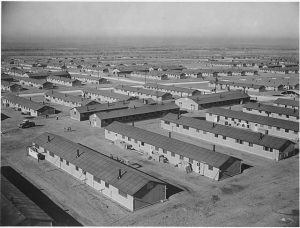World War II was a dark time in history. Countless lives were lost or destroyed both on and off the battlefield. World War II cannot be discussed without mention of the Holocaust and the Nazi’s despicable crimes against Jews. Meanwhile, Americans don’t seem to be taught, or choose not to remember, the internment of Japanese Americans after the events of Pearl Harbor. The United State’s crimes against its own citizens is being forgotten, but archeology is saving this history from being erased.
Executive order #9066 ordered the internment of Japanese Americans into camps along the western portion of the United States. They were imprisoned for crimes they had not committed and lost all they had worked for in the United States. Their houses were no longer theirs, most of their possessions were lost, they couldn’t work, their culture was being taken away from them, and they were seen as the enemy by their former neighbors. Over two-thirds of the prisoners were American citizens, and their interment was against their rights (Camp). The Japanese Americans relocated to these camps did not know how long they would be staying, or what would be waiting for them when they got out. They suffered at the hands of their own country and it isn’t widely acknowledged by history.
Life within the camps was kept hidden from the outside. Pictures were controlled or not allowed, letters were censored, and prisoners constantly supervised (Camp). This led rumors to spread that the internees were living well, even better than average Americans during the struggles of the war. Archeology is helping reveal the truth of that life was like for the people forced to live there.
Not much is left of these camps, but archeologists are finding remnants that can tell us how Japanese Americans lived and dealt with their internment. Excavation of now vacant camps show evidence that the people housed there attempted to make the most of their stay. They were only permitted to bring one suitcase with bare necessities and forced to sell the rest of their possessions, an essential robbery of their life and heritage since many personal items left behind reflected Japanese culture. So it makes sense that Japanese Americans would try to create their culture where they could. Exterior areas were given a Japanese style with gardens ponds and walkways. Evidence at one Colorado camp even shows that the Japanese Americans altered the soil with eggshells to grow traditional Japanese vegetables (Camp).
Archeologists have also found evidence of high security around the camps. Guard towers and fences gives evidence that those living there were not free to leave, and were in fact prisoners. At some camps prisoners were forced to work; at the Kooskia Camp in Idaho Japanese Americans were forced to build a highway (Banse).
Most people kept in the camps had to start entirely new lives upon their release, forced to acclimate to American life once more. Even after the release of Japanese Americans their suffering continued. They faced racism and xenophobia that hindered their ability to move on and start again. The least history could do is acknowledge the suffering Japanese Americans went through.
References:
Banse, Tom
2012 Archaeologists Resurrect Nearly Forgotten WWII Internment Camp. Northwest News Network
Camp, Stacy Lynn
2015 Landscapes of Japanese Internment. Historical Archeology Volume(50):169-186
Contreras, Russell
2015 Colorado Japanese-American Internment Camp Opens Forgotten History. The Associated Press
Valentino, Claudia
2011 The Archeology of Internment. Archeology
Further Reading:
Scenes from Japanese Internment Today
https://www.nationalgeographic.com/magazine/2018/10/japanese-internment-then-now-portraits/
Archaeology of the Japanese American incarceration
http://encyclopedia.densho.org/Archaeology%20of%20the%20Japanese%20American%20incarceration/



Cool post! I wanted to know if you can tell us how this type of work can be used today to study migration or other contemporary issues regarding identity, racism, and xenophobia that plague our everyday worlds?
Knowledge learned from the plight of Japanese Americans can be applied to the current movement of Syrian refugees. As more people get displaced by violence in the Middle East there is more discussion on where they can go. The United States poor decision to intern innocent civilians should act as a lesson, that the racism these people face is unfounded and based on the actions of only a select few (Eligon). They should not prejudiced against and treated as criminals, but as survivors that deserve help. The artifacts found in Japanese Internment camps can also assist us in understanding what is valuable when people have lost their homes. What do these people really need? The imprisoned Japanese Americans tried to make their surroundings more familiar and add touches of home. Understanding how they coped could help Syrian refugees rebuild themselves. Japanese Internment was a terrible mistake, and the least we could do is learn from it.
Eligon, John
2015 Resistance to Syrian Refugees Calls to Mind Painful Past for Japanese-Americans. The New York Times